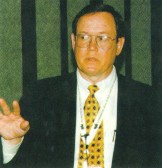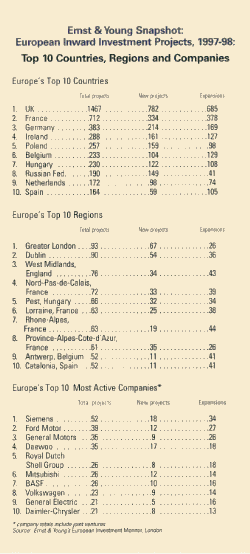C
Above right: “To create economic value added, management will have to provide talented people with the infrastructure that allows them to perform,” IDRC Director of Global Learning Services Robert Materna told the Cannes Conference.
These are some of the highlights of animated discussions the unfolded at the Cannes World Congress of the Industrial Development Research Council (IDRC), the world’s premier corporate real estate association, which drew a record 150-plus. participants. The congress was held here at the luxurious Palais des Congres in conjunction with MIPIM, the world’s No. 1 property show, which drew a record 4,164 companies from 57 countries, a 20 percent increase from 1998’s MIPIM gathering. — Jack Lyne
annes, France: Integration of a new and different sort is advancing on the new Europe:

Like their U.S. corporate counterparts, European companies are feeling the pressure to maximize the synergies of their corporate infrastructure resources (CIR). Responding to the accelerated pace of workplace change generated by rapidly evolving technology, European firms are looking for ways to fuse the management of human resources, (HR) corporate real estate (CRE) and information technology (IT).
But in the new 290-million-person European single currency market, executives will have to fine-tune their strategies to handle the thicket of individual national peculiarities presented within the 11-nation currency zone. Simultaneously, as offices head for the hills in the wake of the Internet revolution, European ways of dealing with space may invade U.S. suburban office buildings.
The concept of managing corporate infrastructure resources as a single mesh of related strategies is rapidly gaining ground, IDRC delegates reported.
For example, Robert Materna, IDRC director of global learning services, cited a IDRC-conducted corporate executive survey in late 1998 in which a whopping 80 percent said they felt that coordinating the mix of HR, IT and CRE as part of an integrated CIR management strategy would increase their companies’ competitiveness. Within the CIR matrix, IT is rising dramatically as a percentage of revenues, as are HR expenditures, despite dislocations, a majority of IDRC-surveyed executives said. Corporate real estate, however, is the part of the CIR grid that is decreasing as a percentage of revenue, the survey showed.
“As costs are rising, CIR aligns corporate real estate and information technology into an integrated management concept. The challenge is to find the right mix,” Materna said.
Europe’s CIR Challenges
Europe’s patchwork-quilt markets present special problems for implementing cohesive management of corporate real estate assets and allied infrastructure resources, most Cannes attendees agreed.
“In Europe, the new reality is the size of the market,” said Jean-Paul Loevenbruck, senior vice president of Paris-based Bourdais Oncor International, which sponsored the IDRC Cannes Congress. “The wave of mergers and acquisitions sweeping the continent is continuing to change the landscape.
“We’re talking about 11 single currency countries with different ways of doing things. It will take time to get to distinguish the Swedes from the Portuguese, the Belgians from the Italians, the Dutch and the French from the Spanish and the Germans. It’s far from a single marketplace yet.”
“Location, location, location” is a major part of the European real estate solution, suggested GE Capital Communications Director Philippe Jouan. “The harsh reality in Europe is that there is a lot of redundant, inefficient space generating negative cash flow,” Jouan explained. “We need intelligent buildings.”
The Flexibility Imperative

Flexibility, most analysts agree, will separate the winners from losers in a rapidly evolving 21st-century marketplace that will continue to be characterized by a high-velocity environment.
“These days, companies explode on the market and may just run for five years and then disappear,” explained Michael Joroff, Massachusetts Institute of Technology senior lecturer in urban studies and planning. “Look at Netscape, which made such a splash. Now, it’s just one more part of AOL.
“The high-performance companies will be those that remain agile enough to modify their strategies quickly to adjust to changes in the marketplace.”
Added Materna, “Firms will have to quantify the impact of being able to quickly expand, contract, change or delay their corporate real estate strategies.”
Above right: “Substitutability is a key new word” in the workplace, Massachusetts Institute of Technology Professor Michael Joroff explained. “If I need to, can I substitute one thing for another?”
Delivering the New Workplace
With those new realities, corporate real estate executives must deliver a different kind of workplace, one that facilitates “any time, anywhere” work, the Cannes conference underscored.
“Technology is changing the way that companies function and how employees get their jobs done,” Joroff explained. “People won’t work from nine to five in offices any more.
“Look at sales. Last year, 12 percent of cars sold in the U.S. were sold on the Internet. When we asked people to draw their offices, 15 percent drew their office connected to a laptop. People increasingly see their workplace as wherever they are with a laptop and a mobile phone. With the drive for greater return on capital, we are looking at lean workplace platforms. It can be your place or my place. Look out the window. Your office is everywhere.”
Materna echoed that assessment, saying, “If companies are going to create economic value added, management will have to provide talented people with the infrastructure that allows them to perform. Alternative workplace solutions are no longer an alternative; they are a necessity.”
New Manufacturing Requirements

New business realities, Cannes attendees emphasized, have also created a new and still-evolving role for real estate in manufacturing facilities, where work-space requirements have undergone marked change. With IT-driven just-in-time manufacturing processes shrinking warehouse space by bringing components to the factory floor only as they’re needed, firms are increasingly scouting for sites that provide both flexible workplaces and short space commitments.
“In addition to low commitment, a new key word is ‘substitutability.’ If I need to, can I substitute one thing for another?” Joroff explained.
In the location battle between city mice and country mice, site selection choices will turn on companies’ particular objectives.
“Some firms will still want monuments that show their presence in big cities,” said Mark Dixon, executive chairman of UK-based Regus. “Look at Sony’s purchase of the ATT building in New York City.
“But IT is allowing firms to develop a whole new series of peripheral gathering points. Today, mobile phones are in the playgrounds. Companies are moving closer to their customers and to their employees. People want to work in places convenient for their lifestyles, and technology will permit this. I see emergence of communities of 15,000 as business centers.”
Loevenbruck agreed; “In 10 to 20 years, you will see business once again in small towns. Technology will have put an end to the long commute.”
The Need for ‘Convening Sites’
Despite the talk of urban flight, cities retain strong attractions for business locations, other Cannes conference participants countered.
Joroff, for example, insisted that command and control systems will require people to gather at central points, if only periodically.
“In spite of all this [corporate diffusion], I do think the center cities will remain strong. People have to convene,” he said.
Another analyst added, “People need a sense of tradition and contact with their peers. Companies can have suburbs, but the center is here to stay.”
Emulating European Design
Designers of suburban centers are already taking a cue from Europe when it comes to building countryside office environments.
“We did the IBM headquarters in Armonk, north of New York City,” explained Eugene Koln, president of New York City-based Koln Peterson Fox. “Essentially, it’s a high-tech building in the woods that looks friendly, accessible and low tech. The distance from the core to the exterior wall is only 35 feet (10.6 meters), which is closer to European norm. Everybody can see daylight, but there are facilities for all the high-tech things IBM does.
“We’re doing lots of low-rise suburban headquarters. In a three- or four-story building, people see more of each other and can meet in courtyards and other rendezvous points. In a high-rise, you often see colleagues only in the lobby or in the elevator.”
For the moment at least, facilities in Europe will favor the city, with individual site choices largely driven by the facility’s mission, analysts at the Cannes conference agreed. Units targeting distribution, for example, favor Europe’s heartland in Belgium, the Netherlands and Eastern France, while high-tech firms favor Ireland, Scotland and London, speakers explained. On the other hand, headquarters still favor sites close to major airports in big urban centers like London, Brussels, Amsterdam, Paris and Frankfurt, they added.
Over the longer term, however, Europe’s location attractions will converge, some attendees predicted. At present, though, real estate executives are being avidly courted by regional development agencies who, in Europe’s scramble to lure big players, are anxious to highlight their areas’ special draws.
Said one analyst: “If a development zone is on the edge of Europe, it’s billed as a ‘gateway.’ If it’s in the center it’s called a ‘crossroads.’ You take your pick.” SS
Site Selection European correspondent Michael Sullivan is based in Juan Les Pins, France. Phone, (33) 493-673-877; e-mail, 100664.2415@compuserve.com
